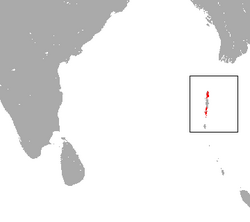Biology:Andaman horseshoe bat
| Andaman horseshoe bat | |
|---|---|
| Scientific classification | |
| Domain: | Eukaryota |
| Kingdom: | Animalia |
| Phylum: | Chordata |
| Class: | Mammalia |
| Order: | Chiroptera |
| Family: | Rhinolophidae |
| Genus: | Rhinolophus |
| Species: | R. cognatus
|
| Binomial name | |
| Rhinolophus cognatus K. Andersen, 1906
| |

| |
| Andaman horseshoe bat range | |
| Synonyms | |
|
Rhinolophus famulus | |
The Andaman horseshoe bat (Rhinolophus cognatus) is a species of bat in the family Rhinolophidae. It is endemic to the Andaman Islands.[1] During the day, it roosts in caves, but may also choose tree hollows.[2]
Taxonomy
The Andaman horseshoe bat was first collected by Italian zoologist Enrico Hillyer Giglioli in May 1892. It was collected in Port Blair of the Andaman Islands. The specimen was taken to the Museo Civico di Storia Naturale di Genova, where it was described by Danish zoologist Knud Andersen in 1906.[3]
As the horseshoe bat genus is very speciose, it is further divided into closely related species groups. The Andaman horseshoe bat is placed into the pusillus species group.[4] Other species belonging to this species group include:
- Acuminate horseshoe bat, R. acuminatus[5]
- Convex horseshoe bat, R. convexus[6]
- Little Japanese horseshoe bat, R. cornutus[7]
- Imaizumi's horseshoe bat, R. imaizumii[8]
- Blyth's horseshoe bat, R. lepidus[4]
- Formosan lesser horseshoe bat, R. monoceros[8]
- Osgood's horseshoe bat, R. osgoodi[8]
- Least horseshoe bat, R. pusillus[8]
- Shortridge's horseshoe bat, R. shortridgei[4]
- Little Nepalese horseshoe bat, R. subbadius[4]
Description
They have long, spatulate lancets. The lateral margins of the lancet are concave.[6] The forearm of this species measures 39–39.7 millimetres (1.54–1.56 in). Their skulls are 17.2–18.6 millimetres (0.68–0.73 in) long.[6] They roost in colonies of fewer than 50 individuals.[1]
Biology
It is known to form mixed-species colonies. Other species that it will roost with include Dobson's horseshoe bat and the Pomona roundleaf bat.[9] During January, individuals have been observed in a state of torpor. Their average generation time is 7.5 years.[1]
Range and habitat
This species is only found on the Andaman Islands. It is not found on the nearby Nicobar Islands. Its upper elevation limit is 600 metres (2,000 ft). During the day, it roosts in caves, although tree cavities are also sometimes used.[1]
Conservation
During surveys in 2013 and 2014, it was noted that this species was absent from previous known roosts in several caves. This could be indicative of a decline in the number of subpopulations, or in the total population. Prior to 2008, this species was listed as vulnerable through the International Union for Conservation of Nature. In 2008, its status was revised to endangered. The species is in danger of becoming extinct due to its restricted range of less than 500 km2 (190 sq mi), its existence in fewer than five locations, and the continued decline in locations of occurrence. While it is not specifically protected by India's Wildlife Protection Act of 1972, most of its habitat is within protected areas or areas with restricted access.[1] Possible threats to this species include disturbance related to edible-nest swiftlet nest harvesting.[2]
References
- ↑ 1.0 1.1 1.2 1.3 1.4 1.5 Aul, B.; Chakravarty, R. (2016). "Rhinolophus cognatus". IUCN Red List of Threatened Species 2016: e.T19533A21981807. doi:10.2305/IUCN.UK.2016-2.RLTS.T19533A21981807.en. https://www.iucnredlist.org/species/19533/21981807. Retrieved 14 November 2021.
- ↑ 2.0 2.1 Aul, Bandana; Bates, P.J.J.; Harrison, D.L.; Marimuthu, G. (2014). "Diversity, distribution and status of bats on the Andaman and Nicobar Islands, India". Oryx 48 (2): 204–212. doi:10.1017/S0030605312000646.
- ↑ Andersen, K. (1906). On some new or little-known bats of the genus Rhinolophus in the collection of the Museo Civico, Genoa. Annali del Museo Civico di Storia Naturalia di Genova, Serie, 3(2), 1905.
- ↑ 4.0 4.1 4.2 4.3 Srinivasulu, C., & Srinivasulu, B. (2012). South Asian Mammals. In South Asian Mammals (pp. 9-98). Springer New York.
- ↑ Bates, P. J.; Thi, M. M.; Nwe, T.; Bu, S. S. H.; Mie, K. M.; Nyo, N.; Khaing, A. A.; Aye, N. N. et al. (2004). "A review of Rhinolophus (Chiroptera: Rhinolophidae) from Myanmar, including three species new to the country". Acta Chiropterologica 6 (1): 23–48. doi:10.3161/001.006.0103. https://www.researchgate.net/publication/233541764.
- ↑ 6.0 6.1 6.2 Csorba, G. (1997). "Description of a new species of Rhinolophus (Chiroptera: Rhinolophidae) from Malaysia". Journal of Mammalogy 78 (2): 342–347. doi:10.2307/1382887.
- ↑ Wu, Yi; Motokawa, Masaharu; Harada, Masashi; Thong, Vu Dinh; Lin, Liang-Kong; Li, Yu-Chun (2012). "Morphometric variation in the pusillus group of the genus Rhinolophus (Mammalia: Chiroptera: Rhinolophidae) in east Asia". Zoological Science 29 (6): 396–402. doi:10.2108/zsj.29.396. PMID 22639811.
- ↑ 8.0 8.1 8.2 8.3 Simmons, N.B. 2005. Order Chiroptera. Pp. 312–529 in Wilson, D.E. and Reeder, D.M. (eds.). Mammal Species of the World: a taxonomic and geographic reference. 3rd ed. Baltimore: The Johns Hopkins University Press, 2 vols., 2142 pp. ISBN:978-0-8018-8221-0. Simmons, N.B. 2005. Order Chiroptera. Pp. 312–529 in Wilson, D.E. and Reeder, D.M. (eds.). Mammal Species of the World: a taxonomic and geographic reference. 3rd ed. Baltimore: The Johns Hopkins University Press, 2 vols., 2142 pp. ISBN:978-0-8018-8221-0
- ↑ Aul, B. 2003. The Status and Distribution of Bats in Andaman and Little Andaman Islands. Madras Crocodile Bank Trust, Mamallapuram, India.
Wikidata ☰ Q1768258 entry
 |


